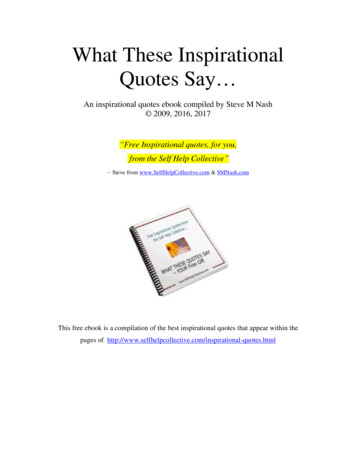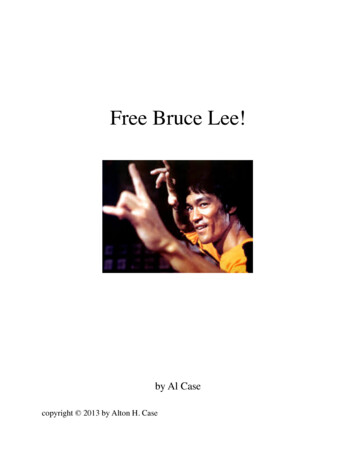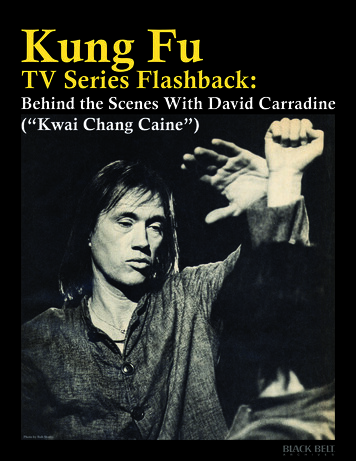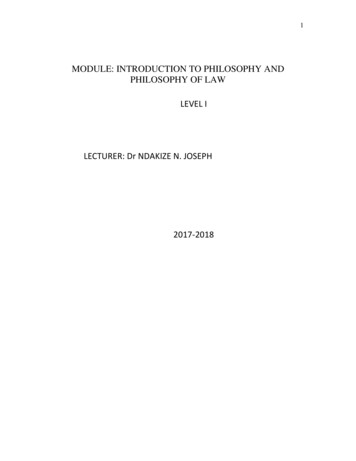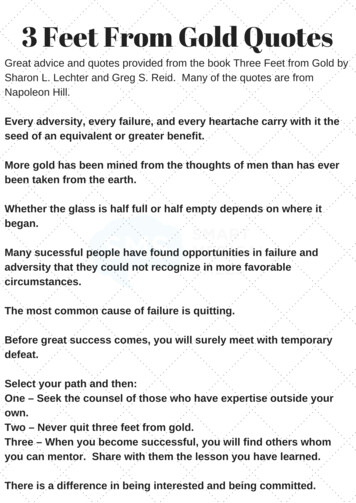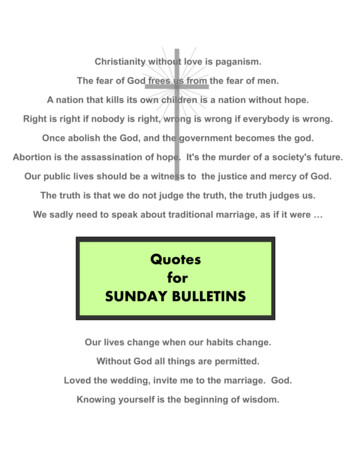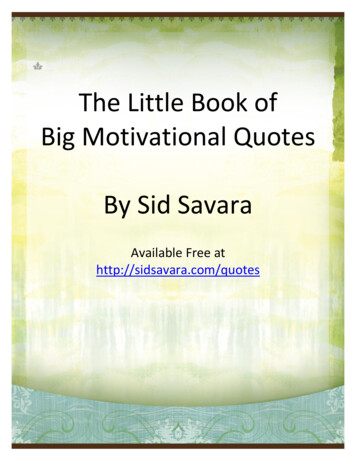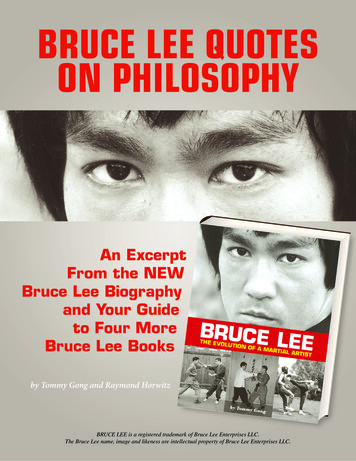
Transcription
BRUCE LEE QUOTESON PHILOSOPHYAn ExcerptFrom the NEWBruce Lee Biographyand Your Guideto Four MoreBruce Lee Booksby Tommy Gong and Raymond HorwitzBRUCE LEE is a registered trademark of Bruce Lee Enterprises LLC.The Bruce Lee name, image and likeness are intellectual property of Bruce Lee Enterprises LLC.
The following is an EXCLUSIVE excerptfrom the forthcoming book/e-bookBruce Lee: The Evolution of a Martial Artistby Tommy GongThis new book traces the path of Bruce Leeas he developed his martial art of jeet kune doand his philosophy of self-actualization.That path led Lee from Hong Kong to Seattle and then to Oakland and then to Los Angeles and then back to Hong Kong as he evolvedfrom a student of wing chun to the founder of jeet kune do.Through his quest for the ultimate martial art,Lee ultimately discovered himself.This excerpt features content fromChapter 7 — The Mind of Bruce Lee:Glimpses Into the Soul and Psyche of the Little Dragon.BRUCE LEE is a registered trademark of Bruce Lee Enterprises LLC.The Bruce Lee name, image and likeness are intellectual property of Bruce Lee Enterprises LLC.DISCLAIMERBLACK BELT COMMUNICATIONS, an Active Interest Media Publication, as publisher, does not endorse and makes no representation, warranty or guarantee concerning the safety or effectiveness of either theproducts and services advertised in this magazine or the martial arts or other techniques discussed or illustrated in this document. The publisher expressly disclaims any and all liability relating to the manufacture,sale or use of such products and services and the application of the techniques discussed or illustrated in this document. The purchase or use of some of the products, services or techniques advertised ordiscussed in this document may be illegal in some areas of the United States or other countries. Therefore, you should check federal, state, and local laws prior to your purchase or use of these products,services or techniques. The publisher makes no representation or warranty concerning the legality of the purchase or use of these products, services and techniques in the United States or elsewhere. Becauseof the nature of some of the products, services and techniques advertised or discussed in this document, you should consult a physician before using these products or services or applying these techniques.Specific self-defense responses illustrated in this document may not be justified in any particular situation in view of all of the circumstances or under applicable federal, state or local law. Neither Black BeltCommunications nor the author makes any representation or warranty regarding the legality or appropriateness of any technique mentioned or depicted in this document. You may be injured if you apply or trainin the techniques illustrated in this document and neither Black Belt Communications nor the author is responsible for any such injury that may result. It is essential that you consult a physician regarding whetheror not to attempt any technique described in this document.
198
CHAPTER 7The Mind of Bruce Lee: Glimpses into theSoul and Psyche of the Little DragonMost people need to overcome the temptationof being completely in awe of Lee’s physiqueand prowess as a martial artist to appreciatefully everything he had to offer, including hisintellect. This appreciation for Lee’s physicalitywas especially strong due to his groundbreakingappearances on television and in movies. However,he also developed into a profound thinker,discovering the truth for himself when readingmany of the great philosophers of the past andpresent. It was through this search for the truththat he gained the intellectual self-sufficiency andcourage to break away from stifling traditions andevolve his martial arts.Those who personally knew Lee were able to realizehis genius not only as a martial artist, but as ahuman being. Many personal students mentionhow good they felt being around him and how hemotivated and instilled confidence in them. StirlingSilliphant once said, “In my whole life, no man, nowoman, was ever as exciting as Bruce Lee.” Howis it that a man could have such apositive effect on not only those whoknew him, but those who were bornafter he passed on? Most likely it washow his self-knowledge, his supremeconfidence in himself and his positiveoutlook on life were expressed in hispresence on screen and his physicalart of expressing the capabilities ofthe human body that inspire all of us.199
CHAPTER 7Creative Life ForceEven at a young age, Lee felt the creative life force withinhim and it gave him purpose in life; it drove his being.He knew he would accomplish much since he refusedto give in to failure or setbacks. It was this doggeddetermination that allowed him not only to become,arguably, the greatest martial artist who ever lived, butalso the groundbreaking Asian actor who would beuniversally recognized around the world even today. Ina letter to Pearl Tso in September 1962, he expressed thisbelief openly:I feel I have this great creative and spiritual force withinme that is greater than faith, greater than ambition,greater than confidence, greater than determination,greater than vision. It is all these combined . Whether itis a godhead or not, I feel this great force, this untappedpower, this dynamic something within me. This feelingdefies description, and [there is] no experience with whichthis feeling may be compared. It is something like a strongemotion mixed with faith, but a lot stronger.When you drop a pebble into a pool of water, the pebble starts a series of ripples that expand untilthey encompass the whole pool. This is exactly what will happen when I give my ideas a definiteplan of action. Right now I can project my thoughts into the future. I can see ahead of me. I dream(remember that practical dreamers never quit) . I am not easily discouraged, readily visualize myselfas overcoming obstacles, winning out over setbacks, achieving “impossible” objectives.Reflecting on his own self-realization, Leelater wrote in the early ’70s about selfdiscovery and harnessing the powers withinone in the screenplay for the Silent Flute:When a man comes to a consciousvital realization of those great spiritualforces within himself and begins to usethose forces in science, in business, andin life, his progress in the future will beunparalleled.200
THE MIND OF BRUCE LEESelf-Knowledge and Personal ExpressionLee said all types of knowledge ultimately mean selfknowledge. He realized in all learning, whether it is in themartial arts, academia, relationships or anything in life, theexperience reveals more of one’s being to one’s self. In this way,one must be willing to learn from the challenges in life andhow to adapt to attain success. Like Krishnamurti, Lee believedlearning cannot be accomplished in isolation, but ratherthrough relationships to people, ideas and events. So, althoughjeet kune do is a martial art, the learning process one cultivatesis to be used in everyday life:Self-knowledge is the basis of JKD because it is effective, notonly for the individual’s martial art, but also for his life as ahuman being. 75To me, at least the way that I teach it, all types of knowledgeultimately means self-knowledge. So, therefore they’re coming in [other actors] and asking me to teachthem not so much how to defend themselves or how to do somebody in. Rather, they want to learn toexpress themselves through some movement, be it anger, be it determination or whatever. So, in otherwords, they’re paying me to show them, in combative form, the art of expressing the human body. 76To know oneself is to study oneself in action with another person.Learning is definitely not mere imitation or the ability to accumulate and conform to fixed knowledge.Learning is a constant process of discovery and never a concluding one. In JKD we begin not byaccumulation but by discovering the cause of our ignorance, and oftentimes this involves a sheddingprocess . Truth will not come until we have come to understand personally the whole process of theworking of our being. After all, ultimately, knowledge in martial art simply means self-knowledge, andJKD can become intelligible only in the vigorous and constant process of self-inquiry and self-discovery.One must be free to express one’s self honestly, whether it be in martial arts or acting. The truly greatpainters and sculptors of the past had a vision in their souls and it was reflected in their works of art.Despite the political pressure they may have experienced, their patrons’ intentions or the beliefs of theircontemporary artists, the true masters expressed themselves on the canvas or marble. Lee expressedhimself in physical form and he realized the need to be devoid of styles or systems in order to have thecomplete freedom truly to express himself:75Ibid. p. 208.76Excerpt from The Pierre Berton Show, “Bruce Lee: The ‘Lost’ Interview.” 1971.201
CHAPTER 7I do not believe in styles anymore. I do not believe thatthere is such a thing as “the Chinese way of fighting” or “theJapanese way of fighting,” or any other “way of fighting,”because unless a human being has three arms and fourlegs, there can be no different form of fighting. Basically, wehave only two hands and two feet. Styles tend to separatemen, because they have their own doctrines, and thedoctrine became the gospel truth that you cannot change!But, if you do not have styles, if you just say, “Here I amas a human being, how can I express myself totally andcompletely?”—that way, you won’t have a style, becausestyle is a crystallization. This approach [means] continuinggrowth . To me, ultimately, martial art means honestlyexpressing yourself. 77When I look around, I always learn something and that is tobe always yourself. And to express yourself. To have faith inyourself. Do not go out and look for a successful personalityand duplicate it. Start from the very root of [your] being,which is “how can I be me?” 78As a result, Lee had a personal approach for individualgrowth:Research Your Own ExperienceAbsorb What is UsefulReject What is UselessAdd What is Specifically Your OwnContemporary Western ThinkingWhereas Lee’s philosophy was a melding of Eastern and Western thought, Ted Wong liked to refer to JKDas contemporary Western thinking. While Lee began his search for truth in martial arts with the Chineseclassical philosophies such as Taoism and Zen, he took the extra steps to open up his thinking extensivelyto many different philosophers. The very fact that Lee was willing to look “outside the box” and not bebound by tradition followed the practical approach of the Western world. For Lee, jeet kune do wasnonclassical, not traditional, so its approach was contemporary.20277Ibid.78Ted Thomas audio interview with Bruce Lee, part 2, 1971.
THE MIND OF BRUCE LEELee also realized he possessed unique physicalcapabilities that many of his students did not.Jeet kune do, as Lee performed it, is not foreveryone because the average person simplydoes not possess the skills and has not investedthe amount of training Lee had. Therefore, Leeencouraged his students to find what workedbest for them, exploiting and capitalizing ontheir strengths in their training. This was anonclassical approach to gung fu, as opposedto the rigid style or system that insisted itsfollowers fit a mold.Lee and WongThe Responsibility of a Teacher“A good teacher protects his pupils from his own influence.” 79When considering his role as a teacher, Lee taught that he wasmerely a “pointer of the truth” instead of a giver of truth. As hetaught the young man in that early scene from Enter the Dragon:“Like a finger pointing a way to the moon. Don’t concentrate onthe finger or you will miss all that heavenly glory.”Lee realized students often came for training because theywere looking for something they were missing. However, thesystematic approach to standardized teaching would onlyserve to make students conform rather than pinpoint thepersonal need.Unfortunately, most of the students in martial art areconformers. The student seldom learns to depend upon himselfEnter the Dragonfor expression. Instead, he faithfully or blindly follows aninstructor, the authority figure, and his instructor’s imposedpattern. That way, the student feels he is no longer alone and finds security in mass imitation. However,what is nurtured is the dependent mind rather than independent inquiry, which is so essential togenuine understanding. So through daily conditioning a student will probably be skilled according to apattern, however, he will not come to understand himself. 8079Lee, Bruce. Bruce Lee: My Martial Arts Training Guide—Jeet Kune Do. London: Universal-Tandem Publishing, 1974.80Ibid.203
CHAPTER 7Lee understood that teaching was highly specialized and lessons mustbe customized to the needs of each unique student: “There is no fixedteaching. All I can provide is an appropriate medicine for a particularailment.” 81ORDER TODAY!BRUCE LEETHE EVOLUTION OF A MARTIAL ARTISTPRINT 29.95 E-BOOK 21.95Lee also realized the teacher must be careful not to instill all of hispersonal preferences on the student, so that, ultimately, the student mustdetermine what will work for him:A teacher, a really good teacher, is never a giver of truth; he is a guide,a pointer to truth. Therefore, a good teacher, or, more appropriately,a guide, studies each student individually and helps to awaken thestudent to explore himself, both internally and externally, and ultimately to integrate himself with hisbeing . All in all, a teacher acts as a catalyst, and not only must he have a tremendous understanding;he must also possess a sensitive mind with great flexibility and adaptability.While Bruce was in Hong Kong, extremely busy dubbing one of his films, he expressed the culminationof his thoughts on martial arts in a letter to an individual named John who was interested in learning jeetkune do: I’m willing—when time permits—to honestly express or “to open myself ” to you, to act as a sort ofsign pole for a traveler.My experience will help, but I insist and maintain that art—true art that is—cannot be handed out.Furthermore, art is never decoration or embellishment. Instead it is a constant process of maturing (inthe sense of NOT arrived!).You see, John, when we have the opportunity of workingout, you’ll see that your way of thinking is definitely notthe same as mine. Art, after all, is a means of acquiring“personal” liberty. Your way is not my way nor mine yours.So whether or not we can get together, remember well thatart “LIVES” where absolute freedom is. With all the trainingthrown to nowhere, with a mind (if there is such a verbalsubstance) perfectly unaware of its own working, with the“self ” vanishing nowhere the art of JKD attains its perfection.81204Tao of Jeet Kune Do. p. 9.
YOUR GUIDE TO BRUCE LEE’SESSENTIAL BOOKSby Raymond HorwitzChinese Gung Fu: The Philosophical Art of Self-Defense —Revised and UpdatedWhy this book matters: digitally restored BruceLee pictures from the early1960s, before he was “BruceLee: martial arts icon atlarge” previously unpublishedBruce Lee pictures withhandwritten annotations contains an early glimpse atthe early evolution of BruceLee’s philosophy before hislater work in Tao of Jeet Kune Do new editorial entries by Shannon Lee and Linda LeeCadwell for the 2008 edition, offering context forthe refurbishment project itself and the new contentadded by Black Belt Books as provided by Bruce LeeEnterprises original sketches and handwritten Chinese characters byBruce Lee himself, painstakingly scanned and cleanedfor maximum clarity in printBruce Lee’s Fighting Method: The Complete EditionWhy this book matters: one word: economy this is four Bruce Lee trainingbooks in one the most explicit, step-by-step, detailed presentation ofBruce Lee’s training methods out of all the Bruce Leebooks available on the market references many of the concepts later found in the BruceLee philosophy book Tao of Jeet Kune Do and shows youBruce Lee’s training methods for experiencing them on aphysical level it’s certainly the largestof the Bruce Lee trainingbooks available, clocking inat nearly 500 pages more than 900 Bruce Leepictures featuring jeetkune do founder BruceLee training, working out,executing stances and drills,fighting — you name it, it’sin thereTao of Jeet Kune Do: Expanded EditionWhy this book matters: Bruce Lee philosophy pulled from hundreds of sourcesin his personal library and from his personal notes onlife, martial arts and their real-time intersection original Bruce Leesketches painstakinglyscanned for maximumclarity in print editorial commentariesby Linda Lee Cadwell,Shannon Lee, TimTackett, Jerry Poteet,Richard Bustillo andmany others the best glimpse intoBruce Lee’s mind,where all the booksBruce Lee read and allthe training Bruce Lee went through came together intoan epic treatise referred to and studied by martial artistsof all styles around the worldBruce Lee: Wisdom for the WayWhy this book matters: ideas from Bruce Lee’sphilosophy paired withBruce Lee pictures, woveninto beautiful artisticdisplays reflective of theconcepts presented in hisquotes perfect for meditationpractice the smallest of our BruceLee books — it can fit inyour pocketBRUCE LEE is a registered trademark of Bruce LeeEnterprises LLC. The Bruce Lee name, image and likenessare intellectual property of Bruce Lee Enterprises LLC.
jeet kune do is a martial art, the learning process one cultivates is to be used in everyday life: Self-knowledge is the basis of JKD because it is e ective, not only for the individual’s martial art, but also for his life as a human being. 75 To me, at least the way that I teach it

